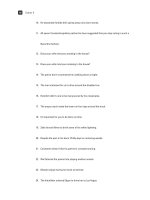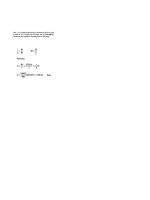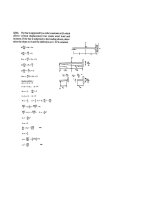- Trang chủ >>
- Đại cương >>
- Toán rời rạc
Lecture Mechanics of materials (Third edition) - Chapter 10: Columns
Bạn đang xem bản rút gọn của tài liệu. Xem và tải ngay bản đầy đủ của tài liệu tại đây (547.15 KB, 10 trang )
<span class='text_page_counter'>(1)</span><div class='page_container' data-page=1>
<b>MECHANICS OF </b>
<b>MATERIALS</b>
<b>Ferdinand P. Beer</b>
<b>E. Russell Johnston, Jr.</b>
<b>John T. DeWolf</b>
<b>Lecture Notes:</b>
<b>J. Walt Oler</b>
<b>Texas Tech University</b>
CHAPTER
</div>
<span class='text_page_counter'>(2)</span><div class='page_container' data-page=2>
Stability of Structures
Euler’s Formula for Pin-Ended Beams
Extension of Euler’s Formula
Sample Problem 10.1
Eccentric Loading; The Secant Formula
Sample Problem 10.2
Design of Columns Under Centric Load
Sample Problem 10.4
</div>
<span class='text_page_counter'>(3)</span><div class='page_container' data-page=3>
Stability of Structures
• In the design of columns, cross-sectional area is
selected such that
- allowable stress is not exceeded
<i>all</i>
<i>A</i>
<i>P</i> <sub>σ</sub>
σ = ≤
- deformation falls within specifications
<i>spec</i>
<i>AE</i>
<i>PL</i> <sub>δ</sub>
δ = ≤
</div>
<span class='text_page_counter'>(4)</span><div class='page_container' data-page=4>
• Consider model with two rods and torsional
spring. After a small perturbation,
(
)
moment
ing
destabiliz
2
sin
2
moment
restoring
2
=
∆
=
∆
=
∆
θ
θ
θ
<i>L</i>
<i>P</i>
<i>L</i>
<i>P</i>
<i>K</i>
</div>
<span class='text_page_counter'>(5)</span><div class='page_container' data-page=5>
Stability of Structures
• Assume that a load <i>P</i> is applied. After a
perturbation, the system settles to a new
equilibrium configuration at a finite
deflection angle.
( )
θ
θ
θ
θ
sin
4
2
sin
2
=
=
=
<i>cr</i>
<i>P</i>
<i>P</i>
<i>K</i>
<i>PL</i>
<i>K</i>
<i>L</i>
<i>P</i>
• Noting that <i>sin</i>
θ
<i>< </i>θ
, the assumed</div>
<span class='text_page_counter'>(6)</span><div class='page_container' data-page=6>
• Consider an axially loaded beam.
After a small perturbation, the system
reaches an equilibrium configuration
such that
0
2
2
2
2
=
+
−
=
=
<i>y</i>
<i>EI</i>
<i>P</i>
<i>dx</i>
<i>y</i>
<i>d</i>
<i>y</i>
<i>EI</i>
<i>P</i>
<i>EI</i>
<i>M</i>
<i>dx</i>
<i>y</i>
<i>d</i>
• Solution with assumed configuration
can only be obtained if
( )
2
2
<i>L</i>
<i>EI</i>
<i>P</i>
</div>
<span class='text_page_counter'>(7)</span><div class='page_container' data-page=7>
Euler’s Formula for Pin-Ended Beams
( )
( )
<i>s ratio</i>
<i>slendernes</i>
<i>r</i>
<i>L</i>
<i>tress</i>
<i>critical s</i>
<i>r</i>
<i>L</i>
<i>E</i>
<i>A</i>
<i>L</i>
<i>Ar</i>
<i>E</i>
<i>A</i>
<i>P</i>
<i>A</i>
<i>P</i>
<i>L</i>
<i>EI</i>
<i>P</i>
<i>P</i>
<i>cr</i>
<i>cr</i>
<i>cr</i>
<i>cr</i>
2
2
2
2
2
2
2
=
=
=
=
=
>
=
=
>
π
π
σ
σ
σ
π
</div>
<span class='text_page_counter'>(8)</span><div class='page_container' data-page=8>
• A column with one fixed and one free
end, will behave as the upper-half of a
pin-connected column.
• The critical loading is calculated from
Euler’s formula,
(
)
length
equivalent
2
2
2
2
2
=
=
=
=
<i>L</i>
<i>L</i>
<i>r</i>
<i>L</i>
<i>E</i>
<i>L</i>
<i>EI</i>
<i>P</i>
<i>e</i>
<i>e</i>
<i>cr</i>
<i>e</i>
<i>cr</i>
π
σ
</div>
<span class='text_page_counter'>(9)</span><div class='page_container' data-page=9></div>
<span class='text_page_counter'>(10)</span><div class='page_container' data-page=10>
An aluminum column of length L and
rectangular cross-section has a fixed end at B
and supports a centric load at A. Two smooth
and rounded fixed plates restrain end A from
moving in one of the vertical planes of
symmetry but allow it to move in the other
plane.
a) Determine the ratio a/b of the two sides of
the cross-section corresponding to the most
efficient design against buckling.
b) Design the most efficient cross-section for
the column.
<i>L</i> = 20 in.
</div>
<!--links-->









